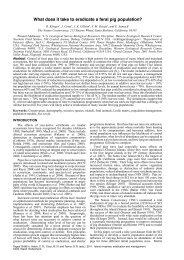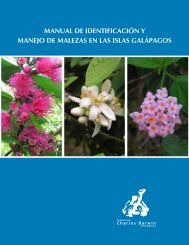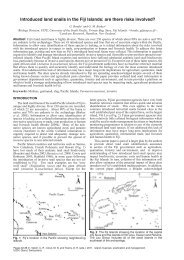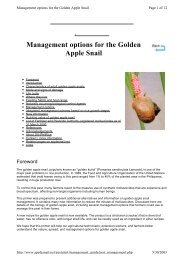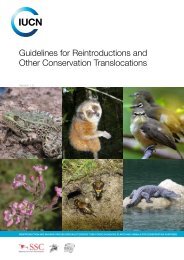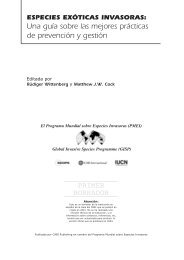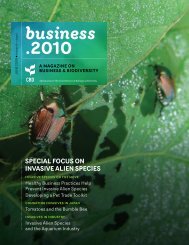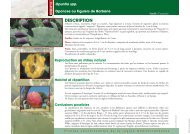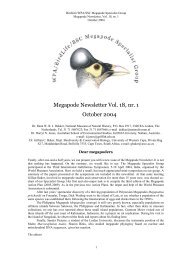Aliens Newsletter - ISSG
Aliens Newsletter - ISSG
Aliens Newsletter - ISSG
Create successful ePaper yourself
Turn your PDF publications into a flip-book with our unique Google optimized e-Paper software.
Giant African Land Snail (Achatina fulica): new entry on a list<br />
of allochtonous mollusc species in Slovakia<br />
Jozef Sˇteffek & Peter Kusˇík<br />
As of the beginning of the 21st century several new<br />
entries have been included on the list of molluscs<br />
of Slovakia. Majority of the species became wide<br />
spread and invasive outside their original distribution<br />
area. Arion lusitanicus (J. Mabile, 1868) was<br />
recorded as one of the first invasive molluscs‘<br />
species in Slovakia in 1992. First observation of its<br />
massive distribution in the country is dated back in<br />
2002 and since then the population size has multiplied<br />
(Dvorˇák, Čejka, 2002).<br />
Similar scenario has been observed for the southeast<br />
Asian mussel Sinanodonta woodiana (Lea,<br />
1834). First record of the species was published by<br />
Kosˇel (1995) who found it in the Ipelˇ River. Later<br />
on the species has widely spread into rivers in the<br />
southern area of Slovakia. At present it is one of the<br />
biggest freshwater mussels in Slovakia. The mussel<br />
could reach the width of 30 cm. High population<br />
density, several hundreds of thousands of specimens<br />
(S ˇ teffek et al., 2002), of Corbicula fluminea<br />
(O.F. Müller, 1774) has been detected in the Slovak<br />
part of the Danube River. The average size of the<br />
mussel is 2 cm and the species is now common in<br />
the aquatic ecosystems of the Danube tributaries in<br />
the Slovak territory.<br />
At the beginning of 2009 Dr. Horsák from the<br />
Masaryk University in Brno, Czech Republic, revised<br />
old records of the genus Lucilla from Slovakia<br />
and recognized the presence of the both Lucilla<br />
singleyana (Pilsbry, 1890) and Lucilla scintilla<br />
(R.T. Lowe, 1852). The latter, L. scintilla is North-<br />
American subterranean species first recorded in Slovakia<br />
in 1996. It was found in the deposit of the<br />
Hron River and published by S ˇ teffek (2003) as a<br />
record of L. singleyana. Both the species have small<br />
shells of size up to 3 mm and have been found on<br />
three localities in Slovakia (Horsák et al., in print).<br />
In 2006 S ˇ teffek and Ádám (2006) published a record<br />
of one individual of Eobania vermiculata (O.F.<br />
Müller, 1774) from the Rimavská kotlina basin. It<br />
is presumed that due to the climate change this<br />
species occurs in other parts of the country as well.<br />
The most recently recorded invasive mollusc in Slovakia<br />
is the Giant African land snail (Achatina fulica<br />
Bowdich, 1822). The species was found in Velˇky<br />
Krtísˇ on the 2nd of July 2009 in the morning. It originates<br />
in Central Africa and was introduced into Singapur<br />
as a supply for soldiers during The Second<br />
World War. From Singapur it has spread throughout<br />
the entire Asia, to the Pacific Islands, India, Australia,<br />
North America and Carribean. It is a herbivor<br />
and in many European countries it has been used<br />
commercially for a meat production. The height of<br />
a fully grown shell could reach 7 cm, the body<br />
length could be 20 cm.<br />
Achatina fulica, an individual found in Slovakia.<br />
Photo: P. Kusik<br />
One of the non-native but not invasive species occuring<br />
in Slovakia is Drobacia banaticum (Rossmässler,<br />
1836), south-east-Carpathian species one<br />
exemplar of which was found in the alluvium of the<br />
Tisa River in the Vychodoslovenská ´<br />
nízˇina flood-<br />
plain in 2007 (S ˇ teffek, 2007). During the last interglacial<br />
period it was a common species throughout<br />
the whole Europe. The most northern presence of<br />
the species has been observed nearby the border between<br />
Slovakia and Hungary on the Hungarian side.<br />
It is most probable that the species will find a suitable<br />
ecological conditions and establish its stabile<br />
populations in Slovakia as well.<br />
Any information on distribution of invasive and<br />
non-native molluscs species in Slovakia should be<br />
sent to prof. S ˇ teffek (steffekjozef@yahoo.com).<br />
<strong>Aliens</strong> 55



